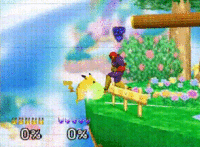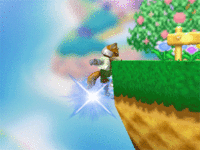| Welcome to SmashWiki! Log in or create an account and join the community, and don't forget to read this first! |
| Notices |
|---|
| The Skill parameter has been removed from Smasher infoboxes, and in its place are the new "Best historical ranking" and "Best tournament result" parameters. SmashWiki needs help adding these new parameters to Smasher infoboxes, refer to the guidelines here for what should be included in these new parameters. |
| When adding results to Smasher pages, include each tournament's entrant number in addition to the player's placement, and use the {{Trn}} template with the matching game specified. Please also fix old results on Smasher pages that do not abide to this standard. Refer to our Smasher article guidelines to see how results tables should be formatted. |
| Check out our project page for ongoing projects that SmashWiki needs help with. |
Planking
- "Plank" redirects here. For the tournament director, see Smasher:Plank.

Planking is a form of camping that abuses the intangibility of stage ledges. Named after a Meta Knight player from Maryland called Plank, planking refers to repeatedly dropping off the ledge and grabbing it again, gaining protection given from the intangibility frames obtained from grabbing the ledge. Planking is possible in the original Super Smash Bros., Super Smash Bros. Melee, and Super Smash Bros. Brawl, but it is especially difficult to edgeguard against in Brawl, due to larger ledge sweetspots, more generous intangibility given to players interacting with the ledge, a larger pool of characters that can effectively perform planking, and that Smash 64 and Melee lack high-tiered characters that can plank well. In Super Smash Bros. Ultimate, the only character that can authentically plank with intangibility is Steve. By landing on any block they place off stage, the character can refresh their ledge grab invincibility.
Planking is noteworthy as a tactic due to how difficult it can be to intercept; attempts to attack the planker can be met with aerial attacks that can set up a gimp KO, while other methods, such as projectiles, are either too inaccurate or too weak to effectively break the planking. Additionally, all characters can plank to some extent in Brawl, though having access to a fast attack that produces a large hitbox to protect the character, and being able to regrab the ledge quickly are attributes that strengthen a character's planking ability. Meta Knight is the most notorious example of a character highly effective at planking, though Mr. Game & Watch and Pit are also examples of characters notorious for highly effective planking; Melee and Smash 64 are notable for lacking many characters that have this property.
Planking is a controversial tactic in Brawl, due to the risk-reward factor typically being heavily skewed in the planker's favor, and the general consensus that heavy utilisation of planking is not enjoyable to fight against nor watch. Meta Knight's extreme planking ability, however, was among the primary reasons why planking was limited, as many players generally thought the tactic was unbeatable. In tournaments, excessive planking is usually limited through a ledge grab rule, though the rule itself does not completely prevent planking (as a player can still plank and not reach the ledge grab limit); a blanket rule in the Brawl ruleset that states "Stalling is banned" can also be applied to planking, though such determinations are up to the discretion of the Tournament Organizer.
Anti-planking[edit]
A Brawl-specific technique discovered by Logic and put on YouTube by VGBootCamp, anti-planking is performed by shielding a planker's aerial attack to cause shield stun. During this, the player can SDI off the stage and hit the planking character, taking advantage of the aerial attack's ending lag. The timing for performing anti-planking varies on what character is performing planking. While it does have the potential to stop planking, anti-planking requires precise inputs from players, especially against Meta Knight, and incorrect inputs can cause the edgeguarding player to self-destruct or get gimped.
Characters notable for anti-planking[edit]
- Diddy Kong: After SDIing off the ledge, Diddy Kong can buffer a down aerial. Compared to other characters, he can recover with greater ease.
- Falco: Falco can use a down aerial, though it cannot be buffered, and is very difficult to recover from.
- Mr. Game & Watch: Mr. Game & Watch can use a down aerial to either meteor smash or stage spike characters, but it can be difficult to recover from.
In competitive play[edit]
Owing to planking's controversial status in Brawl's metagame, a number of rulings have been implemented in an attempt to limit the technique's overall power. Two different rulings have been implemented in Brawl tournaments as to combat planking, with most tournaments opting to use one or the other.
Ledge grab limit[edit]
As excessive planking is generally considered degenerate to Brawl competitive play, the majority of tournaments have a ledge grab limit. This is enforced using the end of match statistics, as the results screen records how many times a player has grabbed the ledge within a match. If a match ends in time out, and a player has grabbed over the amount of times allowed (usually in between 30 and 50 grabs, with Meta Knight usually being allowed significantly fewer ledge grabs), they are disqualified and the opponent wins the game, regardless of remaining stock and damage count. However, if both players exceed the ledge grabbing limit, the normal time out rules apply.
Whether or not ledge grab limits should continue to be implemented is controversial, particularly in tournaments where Meta Knight is banned. An argument against the ledge grab limit is that it is an arbitrary rule that does not actually fix the problem with planking, and it can unfairly punish a player who exceeded the ledge grab limit from being kept offstage often by the opponent, rather than planking with the intention of timing out. Another argument against the ledge grab limit is that planking is a part of the game, that is fully beatable if dealt with properly, and arbitrarily buffs characters that are poor at fighting on the ledge, such as Falco. One more argument is that Meta Knight is the only character whose planking is arguably broken, and with him banned, a ledge grab limit becomes unnecessary and outdated. The ledge grab limit controversy exploded after WHOBO 3, a national tournament that did not implement a ledge grab limit on characters other than Meta Knight; deep in the tournament's bracket, Will defeated Rich Brown through the abuse of ledge grabs,[1] despite having an unfavorable character matchup against Rich Brown. While it has been argued that Rich Brown did not properly combat Will's planking, the match is used for reference as proof that characters other than Meta Knight are capable of unreasonably powerful planking, and to show the degenerate effects unrestricted planking can have on a match. The fallout after the tournament strengthened the support for ledge grab limits, and ledge grab limits have become a universal aspect of US rulesets since.
Air time rule[edit]
An alternative anti-planking rule to ledge grab limits is the air time rule, a rule primarily used in Japan and Mexico. With the air time rule, if a match goes to time out, the end of match statistics are looked at, and the player who spent more time in the air loses, regardless of remaining stock and damage percent. This rule, however, is heavily criticised, and rarely implemented instead of a ledge grab limit in other areas of North America and in Europe. The main criticism of the rule is that it unfairly penalises frequently airborne characters such as Kirby and Wario, while heavily buffing ground-based characters such as Snake and Diddy Kong. Other criticisms of the rule include the fact it overrides the game's time-out rule of rewarding the victory to the player with more stocks, limits air camping and other such tactics the player has to be airborne for despite such tactics not being considered degenerate, and the possibility for the rule to reward victory to a player that was soundly outplayed for something that is not indicative of how each player performed.
In Super Smash Bros. 4 and Super Smash Bros. Ultimate[edit]
Planking is difficult to utilize in a practical manner in Super Smash Bros. 4 and Ultimate due to the games' alternate ledge mechanics. Notably, characters only have ledge intangibility on their first ledge grab; regrabbing the ledge without landing on the stage first or before flinching by an opponent will result in the player grabbing the ledge with no intangibility at all, leaving them open to punishes, such as meteor smashes or attacks that can hit over ledges, such as Villager's forward smash. The introduction of ledge-stealing also weakens planking further, as a player can knock an opponent off the ledge through their ledge intangibility and leave them without their ledge intangibility if they are forced to regrab the ledge.
While generally ineffective, planking still saw use in Smash 4 Bayonetta's metagame. By using Witch Twist to grab and regrab the ledge, she can punish opponents that try to edgeguard her by either overshooting the ledge with her up special and use Witch Time in response, or air dodge onto the stage with her Bat Within mechanic, making it dangerous to punish her at the ledge. Coupled with her safe and numerous recovery options, Bayonetta's ability to avoid edgeguarding with this is one of many reasons for her top tier placement in Smash 4.
Super Smash Bros. Ultimate introduced other changes to further combat planking. Ledge recovery options grant fewer intangibility frames with each regrab, granting no intangibility at all after the fourth ledge grab. Additionally, a player can only grab the ledge a maximum of 6 times before having to land on stage. Attempts to regrab the ledge after this limit will show the particle effect, but the player will not snap to the ledge at all, leaving them in a huge disadvantage. However, if the player is put into hitstun, the 6 grab limit is reset, allowing 6 more regrabs. Interestingly, regrabbing the edge with tether recoveries will still grant intangibility on ledge hanging while decreasing the intangibility on getups.[2] Unlike other special moves, Extreme Speed can grab the ledge after Lucario has grabbed the edge 6 times. However, this will not restore normal edge grabbing outside of Extreme Speed.[3]


